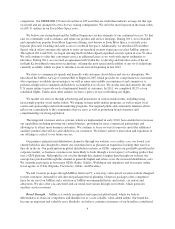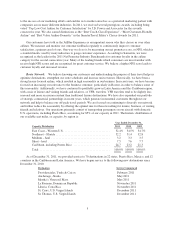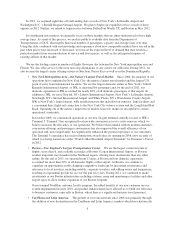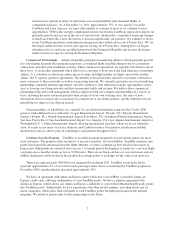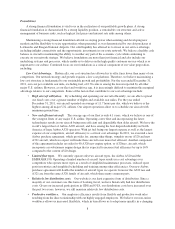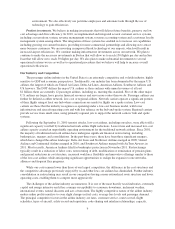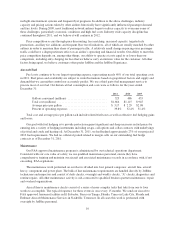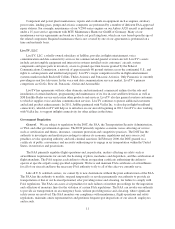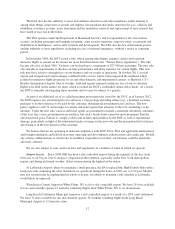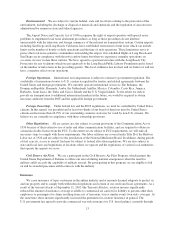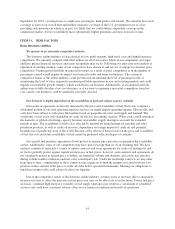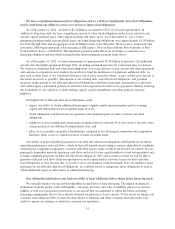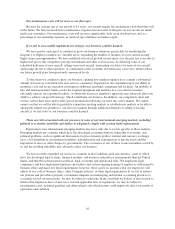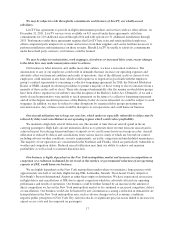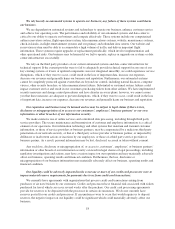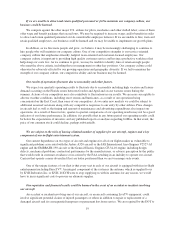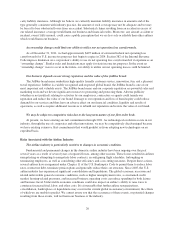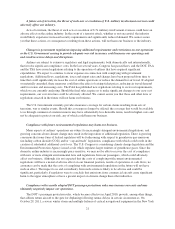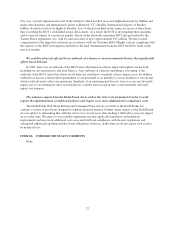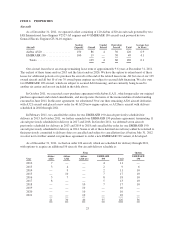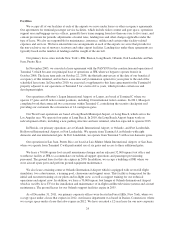JetBlue Airlines 2011 Annual Report Download - page 24
Download and view the complete annual report
Please find page 24 of the 2011 JetBlue Airlines annual report below. You can navigate through the pages in the report by either clicking on the pages listed below, or by using the keyword search tool below to find specific information within the annual report.September 30, 2012, covering losses to employees, passengers, third parties and aircraft. We currently have such
coverage as part of our overall hull and liability insurance coverage. If the U.S. government were to cease
providing such insurance in whole or in part, it is likely that we could obtain comparable coverage in the
commercial market, but we would likely incur substantially higher premiums and more restrictive terms.
ITEM 1A. RISK FACTORS
Risks Related to JetBlue
We operate in an extremely competitive industry.
The domestic airline industry is characterized by low profit margins, high fixed costs and significant price
competition. We currently compete with other airlines on all of our routes. Many of our competitors are larger
and have greater financial resources and name recognition than we do. Following our entry into new markets or
expansion of existing markets, some of our competitors have chosen to add service or engage in extensive price
competition. Unanticipated shortfalls in expected revenues as a result of price competition or in the number of
passengers carried would negatively impact our financial results and harm our business. The extremely
competitive nature of the airline industry could prevent us from attaining the level of passenger traffic or
maintaining the level of fares required to maintain profitable operations in new and existing markets and could
impede our profitable growth strategy, which would harm our business. Additionally, if a traditional network
airline were to fully develop a low cost structure, or if we were to experience increased competition from low
cost carriers, our business could be materially adversely affected.
Our business is highly dependent on the availability of fuel and subject to price volatility.
Our results of operations are heavily impacted by the price and availability of fuel. Fuel costs comprise a
substantial portion of our total operating expenses and are our single largest operating expense. Historically, fuel
costs have been subject to wide price fluctuations based on geopolitical factors and supply and demand. The
availability of fuel is not only dependent on crude oil but also on refining capacity. When even a small amount of
the domestic or global oil refining capacity becomes unavailable, supply shortages can result for extended
periods of time. The availability of fuel is also affected by demand for home heating oil, gasoline and other
petroleum products, as well as crude oil reserves, dependence on foreign imports of crude oil and potential
hostilities in oil producing areas of the world. Because of the effects of these factors on the price and availability
of fuel, the cost and future availability of fuel cannot be predicted with any degree of certainty.
Our aircraft fuel purchase agreements do not protect us against price increases or guarantee the availability
of fuel. Additionally, some of our competitors may have more leverage than we do in obtaining fuel. We have
and may continue to enter into a variety of option contracts and swap agreements for crude oil, heating oil, and
jet fuel to partially protect against significant increases in fuel prices; however, such contracts and agreements do
not completely protect us against price volatility, are limited in volume and duration, and can be less effective
during volatile market conditions and may carry counterparty risk. Under the fuel hedge contracts we may enter
from time to time, counterparties to those contracts may require us to fund the margin associated with any loss
position on the contracts if the price of crude oils falls below specified benchmarks. Meeting our obligations to
fund these margin calls could adversely affect our liquidity.
Due to the competitive nature of the domestic airline industry, at times we have not been able to adequately
increase our fares to offset the increases in fuel prices nor may we be able to do so in the future. Future fuel price
increases, continued high fuel price volatility or fuel supply shortages may result in a curtailment of scheduled
services and could have a material adverse effect on our financial condition and results of operations.
14


